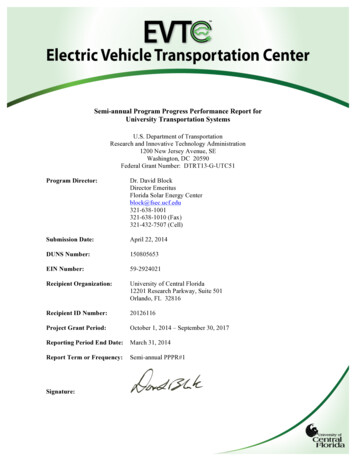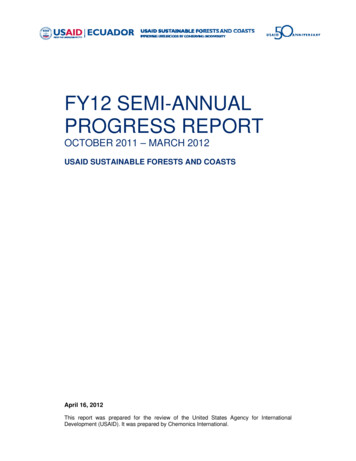
Transcription
Semi-annual Program Progress Performance Report forUniversity Transportation SystemsU.S. Department of TransportationResearch and Innovative Technology Administration1200 New Jersey Avenue, SEWashington, DC 20590Federal Grant Number: DTRT13-G-UTC51Program Director:Dr. David BlockDirector EmeritusFlorida Solar Energy Centerblock@fsec.ucf.edu321-638-1001321-638-1010 (Fax)321-432-7507 (Cell)Submission Date:April 22, 2014DUNS Number:150805653EIN Number:59-2924021Recipient Organization:University of Central Florida12201 Research Parkway, Suite 501Orlando, FL 32816Recipient ID Number:20126116Project Grant Period:October 1, 2014 – September 30, 2017Reporting Period End Date:March 31, 2014Report Term or Frequency:Semi-annual PPPR#1Signature:1
Semi-annual Program Progress Performance Report forElectric Vehicle Transportation CenterSubmitted by:University of Central FloridaI. AccomplishmentsWhat are the major goals and objectives of the program?The Electric Vehicle Transportation Center’s (EVTC) vision is to transform the country’stransportation network into a fully integrated "smart" electric vehicle deployment system coupledwith a "smart" electric grid achieved with maximum efficiency and minimum time anddisruption.To accomplish the EVTC vision, the Center’s goals are to serve as the focal point for the U.S.Department of Transportation’s strategic goal of planning for near-term integration of alternativefuel vehicles as a means to build a sustainable transportation system. The project will evaluatetechnologies, standards and policies to ensure seamless integration of EVs into a complexelectricity grid and transportation network. The EVTC will bridge the gap between deploymentof electric vehicles and the traditional transportation system.To meet the EVTC’s goals the EVTC will undertake five activities as follows: Research andDevelopment, Industry Collaboration, Education and Workforce Development, TechnologyTransfer and Diversity.Research and DevelopmentThe R & D program uses a layered structure consisting of technical sub-tasks leading to the finaldesired output. There are four technical sub-tasks covering the areas of policies, standards, subsystems, and electric vehicle supply equipment analysis. These four sub-tasks feed into the threemajor outputs of specialized EV applications, large-scale social-economic implications andlarge-scale techno-economic systems and analysis.Industry CollaborationCommercial adoption of the advanced technologies developed at the EVTC will requirepartnerships with a variety of external groups. For this reason, the EVTC has begun tocollaborate with national groups (National Renewable Energy Laboratory, Electric PowerResearch Institute), with numerous private utility companies (Duke Energy Florida, FloridaPower and Light, Orlando Utilities Commission) and with transportation groups/agencies(Florida Department of Transportation, Florida Turnpike Authority, Tallahassee StarMetro BusSystem). Additional partnerships are developing as our work progresses.2
Education and Workforce DevelopmentThe EVTC's integrated approach to education brings the experience and capabilities of three topuniversity programs to develop and offer undergraduate and graduate engineering and sciencebased transportation system educational programs. Students receiving degrees or training fromany of the three universities will be well prepared and an asset to the future U.S. workplace.Educational activities include short courses, K-12 education and science, technology,engineering and mathematics (STEM) based programs and careers.In the workforce development area, the University of Central Florida (UCF) will develop, inclose cooperation with state and local workforce agencies, a variety of job stimulation andtraining initiatives. Current efforts include specialized and customized training for new andincumbent workers in the clean energy field. The Central Florida Clean Cities Coalition will alsoplay a major role in workforce development efforts using U.S Department of Energy approvedcurriculum for training new and incumbent workers. The EVTC will also foster the growth ofnew business development using the UCF incubator and Angel Network programs.Technology TransferThe EVTC will conduct technology transfer through participation in professional societymeetings and conference presentations, professional and scholarly publications, industry andconsumer literature development, and outreach using conventional and social media.DiversityThe EVTC team members are a well-rounded and diverse group with an extensive range ofexpertise and capabilities. The EVTC’s commitment to enhance diversity in the transportationfield is demonstrated by partnering with Tuskegee University, a Historically Black College andUniversity (HBCU)/minority serving institution and with the University of Hawaii, a NativeHawaiian-Serving Institution. We will further our diversity efforts by recruiting and developingnew scientific and technical staff to include an emphasis on students.MetricsPerformance metrics for the EVTC program are designed to drive improvement and characterizeprogress and effectiveness. The metrics are applied to enhance performance improvements,efficiency, and appropriate levels of internal controls. They will incorporate "best practices"related to the performances being measured and cost/risk/benefit analysis, where appropriate.Each of the above goals and activities are to be measured against the following metrics table:3
ResearchActivitiesEduc. versityProductivityTimelinessQualityThe evaluation criteria are productivity, timeliness and quality of the project tasks – as they areapplied to EVTC research activities, industry collaboration, education and workforcedevelopment, technology transfer, and diversity. In each box within the metric table thefollowing ranking will be applied: Needs improvement (NI)Satisfactory (S)Exceeds goals (EG)Completed (C)Any item receiving a Needs Improvement will require more definition between the reviewingparties and the item or organization being reviewed.In addition to the metrics, a part of EVTC peer review and best practices procedures isthe guidance by a Steering Committee, comprised of the UCF PI (the EVTC Director), UCF CoPIs and the PIs from the two partner universities. This five-member Steering Committee isresponsible for overall direction and oversight, and has decision-making authority on all EVTCprogram activities. The Steering Committee will evaluate all EVTC projects and incorporateinput from an external Oversight Committee in its decisions. The EVTC Oversight Committeehas been established and its members are: Darryll Dockstader, Research Center Manager, Florida Department of Transportation,Tallahassee, FLMike Faas, Sr. Project Manager, Facilities Administration, Publix Groceries, Lakeland,FLBritta Gross, Director, Advanced Vehicle Commercialization Policy, General Motors,Orlando, FLGeorge Hutchinson, Sr. Director, Power and Energy, Concurrent Technologies Corp.,Arlington, VAJenny Liu, Assistant Professor, Dept. of Civil and Environmental Engineering, Universityof Alaska, Fairbanks, AKHelda Rodriguez, President, NovaCharge Inc., Oldsmar, FLLisa Rice, CareerSource Brevard, Rockledge, FLJennifer Szaro, Orlando Utilities Commission, Orlando, FL4
Thomas Wilke, Business Development and Concessions Manager, Florida TurnpikeEnterprise, Ocoee, FLWhat was accomplished under these goals?Research and Development AccomplishmentsThe major research accomplishments during the first six-month period were the development andrefinement of the research agenda in coordination with the research faculty and partners. Theresult was the identification of 21 individual research projects that address technical, economicand policy aspects of an electric vehicle transportation system. The work on these projects is inthe beginning stages with literature reviews serving as the primary results and accomplishments.The following section presents the 21 projects with each project objective and a summary ofresults to date.POLICIES1. Implications of Electric Vehicle Penetration on Federal and State Highway RevenuesObjective: Research the impact that increased use of electric vehicles will have on federaland state highway revenue sources. This work will identify existing laws and policies thatgovern highway, gas, and vehicle taxes and fees imposed on vehicles and summarize currenttrends and policy recommendations that may influence both the growth of the electric vehiclemarket and impact highway revenues.Accomplishments: Reviewed existing industry and government reports detailing current andfuture predicted fuel tax revenues for the federal highway programs and impacts andshortfalls to highway funding as a result of EV market penetration. Compiled 10 year historyof US fuel revenues and analyzed to predict revenue shortfalls in the event EV sales havemajor current and future impacts on revenues. The analysis shows that current trends in EVsales can result in a 41% decrease in tax revenues (A more detailed report will be preparedfor future publication.). Ongoing review of US government, state and local laws andinitiatives and policies to increase revenue streams from increased EV market share is beingconducted.2. Identify and Analyze Policies that Impact the Acceleration of Electric Vehicle AdoptionObjective: Examine state and national regulatory policies to determine their impact on thelong term adoption of electric vehicles. This work will include a review of initiatives thathave the effect of both encouraging and discouraging the deployment of electric vehicles.Accomplishments: Conducted a literature review of state and federal legislative initiativesand developed a compendium for further analysis.STANDARDS3. Electric Vehicle Charging Technologies and AnalysisObjective: Assess existing electric vehicle charger hardware and software, design, standards,5
and costs. Identify requirements of emerging technologies and applications. Identify andrecommend policies and best practices that advance electric vehicle charging technologiesand deployment.Accomplishments: Currently working with national, regional, and local EV carmanufacturers/dealers to understand the general desire of customers for charging atresidential, public, and workplace locations. Developed contacts with charger companies toaccelerate product penetration in Florida. Continuing dialogues with energy providersregarding electrical grid demand load due to the presence of both level II and DC fastchargers.4. Electric Vehicle and Infrastructure Safety Requirements and RegulationsObjective: Evaluate current and proposed electric vehicle and infrastructure safety standardsand policies with respect to cost and applicable codes, and regulations. The results will beused to evaluate the effects of policies/regulations and on the advancement of electricvehicles and supply equipment.Accomplishments: Completed a literature search of codes and standards typically used forUS electric vehicle and infrastructure projects. The codes and standards are applicable tovehicle systems, batteries, interface and infrastructure. The literature search also included areview of conference proceedings and other commentary on electric vehicle codes andstandards that will be used in the future evaluation process.SUB-SYSTEMS5. Prediction of Electric Vehicle PenetrationObjective: Identify past and present trends in electric vehicle sales to establish a baseline ofelectric vehicle penetration and to project electric vehicle sales and sales characteristicswithin the U.S. Provide projections of sales through the year 2024 for the states of Florida,Hawaii, Alabama, Georgia, California and New York.Accomplishments: Predicted values of PEV yearly sales and cumulative sales have beencollected based on 2013 data. As additional sales data are received, the results will beupdated. The results for the U.S. show that cumulative sales of EVs through 2013 was167,600 vehicles with 96,700 sold in 2013. In other words, 58% of total electric vehicle saleswere in 2013. Depending on the escalation rate selected, the 10 year future U.S. sales (2023)are predicted to be from 250,000 to 1.9 million per year and the cumulative vehicles on theroads will be from 1.9 to 7.3 million vehicles. Comparing the collected results withpredictions from other sources, a growth rate of 20% appears to be most appropriate. A 20%growth rate will give U.S. sales of approximately 600,000 PEVs per year and cumulativesales of 3.2 million PEVs for 2023. This same 20% growth rate will give PEV sales inFlorida, Hawaii and Alabama of 46,000, 11,000 and 6,000, respectively. The cumulativePEV sales for these three states are 241,000, 58,000, and 32,000 vehicles. California ispredicted to sell 186,000 PEVs per year with cumulative sales of 935,000 PEVs.6
6. Electric Vehicle Life Cycle Cost AnalysisObjective: Compare total life cycle costs of electric vehicles, plug-in hybrid electric vehicles,hybrid electric vehicles, and compare with internal combustion engine vehicles. The analysiswill consider both capital and operating costs in order to present an accurate assessment oflifetime ownership costs. The analysis will include vehicle charging scenarios of photovoltaic(solar electric) powered charging and workplace charging.Accomplishments: Preliminary efforts include the review of existing electric vehicleeconomic analysis tools. The vehicle cost calculator found on the U.S. DOE AlternativeFuels Data Center web site will be used as a guide for mileage and fuel use. Additionalresources identified include the Kelly Blue Book web site providing total cost of ownershipand an Electric Power Research Institute report on the life cycle costs of electric vehicles.7. Assess the SunGuide and STEWARD DatabasesObjective: Evaluate the feasibility of using the existing Florida Department of TransportationSunGuide software and STEWARD data base as platforms for analyzing the attributes ofelectric vehicles within present and future transportation infrastructure.Accomplishments: The documentation for accessing and interpreting the Florida basedSunGuide and STEWARD databases has been procured and reviewed. Future efforts willidentify available vehicle information (e.g., number of vehicles, vehicle speed, etc.) for use inEVTC simulation projects.8. Battery Technologies for Mass Deployment of Electric VehiclesObjective: Assess current and emerging battery technologies and the requirements for theircommercialization; align with DOE targets for future EV batteries. Focus will be placed onbattery technologies, charging cycles, lifetimes, safety, codes and standards, and economics.Accomplishments: Literature on battery state-of-the-art, testing protocols and lifetimeanalysis has been reviewed. After discussions among the task researchers, the immediatefuture efforts are to improve information dissemination regarding the various batterychemistries in use or under investigation. This will be accomplished through developing awebsite that will compile research on the components within Li-ion batteries, complete witharticle references. Additional efforts will be devoted to identifying relevant standards fortransporting batteries, as well as determining battery lifetime as a function of operatingtemperatures.9. Electric Vehicle Battery Durability and Reliability under Electric Utility GridOperationsObjective: Determine the impact of electric vehicle use on battery life including chargingcycles and vehicle-to-grid (V2G) applications. The work will identify conditions thatimprove battery performance and durability. Focus will be placed on providing battery datafor system engineering, grid modeling and cost-benefit analysis.Accomplishments: This first phase has been spent collecting information on the batterystate-of-the-art degradation studies and on cell selection. Results have identified two target7
battery chemistries – one a LiFePO4 based battery and the other manganese / cobalt / nickelbase chemistry. A manufacturer for EV applicable graphite / LiFePO4 cells was selected.The next steps will be the selection of the manufacturer for the second selected batterychemistry and drafting a review paper.10. Fuel Cell Vehicle (FCV) Technologies, Infrastructure and RequirementsObjective: Identify state-of-the-art fuel cell technologies and vehicles and currentinfrastructure requirements. A comparison with DOE targets for fuel cell vehicles andcomponents will be included.Accomplishments: The paucity of hydrogen infrastructure presents a major challenge forFCV commercialization. Two feasible types of hydrogen fueling stations have beenidentified: (1) stations relying on hydrogen produced in centralized locations and delivered;(2) stations with onsite hydrogen production from water electrolyzers or steam methanereformers. The choice of hydrogen fueling station types will need to be based on location anddemand. A cost analysis of hydrogen fueling stations has shown cost reductions will beachieved via lowering component costs, standardizing station design and increasing stationcapacity. The most feasible hydrogen infrastructure rollout strategy is to introduce bothhydrogen vehicles and refueling stations in a limited number of geographic areas where earlyadopters are concentrated. A report has been drafted and will be posted on the EVTC website which analyzes key aspects of hydrogen infrastructure and summarizes the leadingresearch efforts in academia, industry, and government agencies. These results will assistFCV stakeholders to take the right steps toward strategic buildup of hydrogen infrastructureand spur FCV market entry. It is noted that with three major automakers (Honda, Hyundai,and Toyota) planning to introduce consumer Fuel Cell Electric Vehicles (FCEVs) by 2016.The project also identified the following future activities. Work will be performed on a casestudy of a fuel cell/battery hybrid bus recently acquired by NASA - Kennedy Space Center.This work will evaluate fuel cell system efficiency, range, durability, and lifespan givencurrent catalyst, membrane and hydrogen storage system technologies. The work will alsoidentify obstacles for mass production, compare the “well to wheel” hydrogen productioncost, compare GHG emissions to other fuels and collate data to project ownership costs ofFCEVs.ELECTRIC VEHICLE SUPPLY EQUIPMENT ANALYSIS11. Electric Vehicle Grid Experiments and AnalysisObjective: Provide experimental data from vehicle-to-grid laboratory simulations. The resultsof the experimental data will be used in the EVTC techno-economic simulation project.Accomplishments: V2G experiments have been defined and anticipate using facilities atFSEC to conduct these experiments. There are approximately 30 kW of photovoltaic (PV)panels that are presently under test, but are not connected to the grid; one of three highlyinstrumented residential test homes; and, the FSEC main office building, which may serve asa commercial office facility. The project identified future work of conducting preliminaryvehicle-to-grid (V2G) experiments using an FSEC test residence augmented with 10 kW of8
PV and/or V2G experiments using the FSEC office building augmented with 15kW of PV.Experiments may include storage to simulate secondary use applications for discarded EVbatteries. Activities include working with stakeholders to acquire instrumentation, batteries,EV battery test stands and V2G inverters for these projects.12. Electric Vehicle Interaction at the Electrical Circuit LevelObjective: Investigate the effect of electric vehicle adoption on the circuit level utilitydistribution grid for both residential and commercial applications by determining the impactof electric vehicle charging and discharging to the grid.Accomplishments: This first phase of the project has collected information on differenttypes of batteries and on electric vehicle chargers (type, rating, programmability). Resultshave identified available EV chargers with their type, rating, programmability and names ofmajor manufacturers. The project identified future work of writing preliminary reports oncurrent state-of-the-art of EV chargers including the inverter technology, embedded sensors,power rating, control capabilities, response time and on the literature search of transientovervoltage mitigation issues and methods at sub circuit level service area with high PV toload ratios. Reports will be prepared on the transient time domain model of a sub circuitservice area that includes the model of EV charger and PV inverters and on potentialsolutions that EV chargers bring to mitigate transient overvoltage at sub circuit level.SPECIALIZED ELECTRIC VEHICLE APPLICATIONS13. Optimal Charging Scheduler for Electric Vehicles on the Florida TurnpikeObjective: Develop the methodology for analyzing the roadway traffic patterns and expectedpenetration and timing of electric vehicles (EVs) on the Florida Turnpike. The work willdetermine the requirements for electric vehicle supply equipment at turnpike plazas, theoptions for equipment siting and the economics.Accomplishments: A preliminary meeting with Florida Turnpike engineers concluded thatthe Florida Turnpike network would be used for this project. Research is being conducted todevelop an average dynamic model of EV traffic flow passing through entrances/exits and aqueuing model for each of the service stations. Their combination will allow the study ofaverage waiting time of EVs at any given service station with respect to traffic flow rate andthe number of chargers available. Following model development, the researchers willinvestigate the problems of designing of a distributed scheduling algorithm for optimizing theoverall transportation network and a cooperative control for individual drivers to make theirdecisions.14. Electric Vehicle Bus SystemsObjective: Model public electric bus transportation systems. The analysis will include routedistance and timing, charging times, impact of type of chargers, maintenance and operationalcharacteristics and economic comparison with diesel powered buses. The first project will beto analyze the City of Tallahassee’s Star Metro electric bus fleet.9
Accomplishments: The project is analyzing five all-electric buses operating in Tallahassee,FL. Tallahassee StarMetro Transit acquired five Proterra all-electric buses and installed aFastFillTM fast charging station in July, 2013. The initial buses cost 1.5 M/bus but the pricehas since dropped to its present asking price of 0.95 M/bus (a diesel bus cost roughly 0.45M). Each electric bus is equipped with an 8-pack of 24V, 72 kWh batteries with a rangeof 30 miles per charge. These buses follow a 20 mile fixed route loop. The fast charger canautomatically charge the buses without drivers’ involvement in 6-7 minutes. The projectidentified future work of developing a MATLAB model to simulate and optimize the routes,stops, passenger pick-up and drop-off schedule, and charging of the electric buses ofStarMetro. The economics (initial cost, operating costs, including electricity, maintenanceand downtimes) of the electric buses will be analyzed and compared to that for aconventional diesel bus. Literature research will be conducted on electric bus technologies,charging stations, and operational experiences.15. Vehicle to Grid Applications Using Electric School BusesObjective: Evaluate the effectiveness of deploying electric school buses for vehicle-to-gridapplications. For a selected application, the research is to analyze the interplay of route traveldistances, battery usage and lifetimes, charge station requirements, inductive chargingoptions, and provision of maximum value to electrical utilities.Accomplishments: The first phase was spent conducting research on the manufacturers andcustomers who have invested in electric bus development, as well as research on ancillaryservices that may be provided through V2G installations.16. Electric Vehicle Fleet Implications and AnalysisObjective: Evaluate the effectiveness of electrical vehicles use in fleet system operations.The focus of this work is to examine route travel distances, battery usage and lifetimes,charging station requirements and economics, as well as how fleet adoption will impactoverall rate of market penetration of electric vehicles.Accomplishments: Fleet outreach efforts revealed that public and private fleet transition toelectric vehicles is limited by a number of factors, including incentives, procurement barriers,and infrastructure limitations. These results will form the basis of future market penetrationresearch.SOCIO-ECONOMIC IMPLICATIONS17. Electric Vehicle Assessment and Societal IntegrationObjective: Evaluate the impacts of electric vehicles and associated renewable powergeneration on reduction of petroleum imports to Hawaii. The analysis will concentrate on theIsland of Oahu and will include the effects of number of vehicles, charging strategies,renewable energy penetration levels and green-house gas reductions.Accomplishments: The initial EV analysis has been completed based on recent HawaiiNatural Energy Institute (HNEI) and General Electric International, Inc. (GE) high fidelitydispatch modeling efforts, (“Oahu Electric Vehicle Charging Study”, 2013). Renewable10
energy base cases were modeled with 600 MW to 1000 MW of combined wind and solarphotovoltaic capacity on the future Oahu grid, with a peak load of about 1200 MW. Gridconnected EVs were explored for their potential to take up the excess or “curtailed” energywhen wind and solar resources exceeded the maximum that could be absorbed into theelectricity grid system. Additional petroleum fuel for electricity generation (to balanceintermittency of wind and solar) was quantified for each future scenario’s EV load.Results showed that under the modeled future renewable energy base cases before EVs wereadded, 10 to 23 percent of the combined wind and solar energy were curtailed. It wasexpected that much of this curtailed energy could be captured by strategically charged EVs.With a very large fleet of EVs and assuming all EVs follow a practical, controlled chargingprofile, curtailed energy was reduced by 18 to 46 percent. Significant reductions in curtailedenergy can be made with modification to Oahu’s grid.18. Socio-economic Implications of Large-scale Electric Vehicle SystemsObjective: Develop models to evaluate the socio-economic implications of a large-scaleelectrified transportation sector. Model factors include effects of vehicle and infrastructuresafety requirements, standardization of vehicle components for safety and charging, electricvehicle supply and after-market economies, displacement of petroleum fuels and impacts ofsustainable development (social, environmental and economic).Accomplishments: An extensive literature review has been undertaken to identify currentresearch gaps. Based on the identified gaps, research is currently investigating the impacts ofregional driving patterns and electricity generation mix scenarios (marginal and average) onenergy use and green-house gas (GHG) emissions of alternative vehicle technologies. Theproject identified future work of investigating how these spatial variations influence thevehicle technology preference at state level. Research will quantify the relative impacts ofbattery and vehicle manufacturing on GHG emissions and energy consumption within thetotal life cycle of vehicles, and to evaluate the impacts implications of alternative policyscenarios.19. Economic Impacts of Electric Vehicle Adoption.Objective: Project will examine likely levels of EV adoption in order to estimate the impactto the State of Hawaii’s economy, and to determine the level of opportunity in EV’s as a gridstabilization tool. Analysis will include the determination of a set of scenarios for EVadoption in Hawaii over time based on consumer vehicle preferences, identifying the impactof EV penetration to the electric sector in terms of electricity generation, costs and GHGemissions, and estimating the effect of EV adoption to the state economy in terms of impactsto gross state product, sector activity and household welfare.Accomplishments: The first phase has been spent collecting literature on vehicle adoptionrates and practices. Results include identification of several sources of Hawaii-specificvehicle fleet data, the beginning of data collection and the vetting of model assumptions.findings/assumptions that will help to form a series of EV adoption scenarios. These will beused as alternative scenarios within the economic analysis. To calibrate the economic model,11
a comprehensive dataset of vehicle fleets in Hawaii will need to be developed which includessensitivity analysis to vehicle adoption rates.TECHNO-ECONOMIC SYSTEMS ANALYSIS20. Techno-economic Analyses of Large-scale Electric Vehicle SystemsObjective: Develop a computer model to evaluate the techno-economic implications of alarge-scale electrified transportation sector. The model factors include developing a networkof electric vehicles that interact with the electric grid, the infrastructure for electric vehiclecharging, integrating the transportation and power systems into the urban setting, studyingthe impact of distributed energy storage and determining the economic impact of increasedrenewable energy and EVs on the electricity grid.Accomplishments: A four-year plan has been developed to subdivide the project intomanageable milestones identified as: 1) identify an external partner and start the developmentof a scalable model of large-scale EV and power grid systems. Partner: Florida TurnpikeAuthority, 2) develop a scalable model of large-scale EV and power grid systems, with theattributes provided by external partners, 3) work on developing and optimizing both G2Vcharging and V2G feeding algorithms, and
Program Director: Dr. David Block Director Emeritus Florida Solar Energy Center block@fsec.ucf.edu 321-638-1001 321-638-1010 (Fax) 321-432-7507 (Cell) Submission Date: April 22, 2014 DUNS Number: 150805653 EIN Number: 59-2924021 Recipient Organization: University of Central Florida 12201 Research Parkway, Suite 501 Orlando, FL 32816











